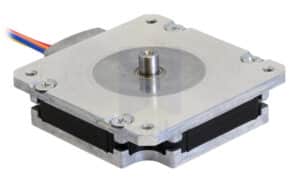Microstepper Motors: Bridging the Gap between Steps
 Step motors possess several qualities that make them ideal for control systems. These include being stiff when stopped, having high torque for their physical size, and being brushless, which makes them virtually maintenance-free. Step motors, however, have a significant drawback when used for precise positioning. A standard hybrid step motor, for example, has a relatively large step size that’s generally 1/200 of a revolution or 1.8 degrees. This large of a step may lead to motor-shaft oscillations at resonance points occurring at low speed. Microstepper motors allow you to retain the advantages of step motors while overcoming low-speed roughness and low resolution—a technique known as microstepping.
Step motors possess several qualities that make them ideal for control systems. These include being stiff when stopped, having high torque for their physical size, and being brushless, which makes them virtually maintenance-free. Step motors, however, have a significant drawback when used for precise positioning. A standard hybrid step motor, for example, has a relatively large step size that’s generally 1/200 of a revolution or 1.8 degrees. This large of a step may lead to motor-shaft oscillations at resonance points occurring at low speed. Microstepper motors allow you to retain the advantages of step motors while overcoming low-speed roughness and low resolution—a technique known as microstepping.
Check out Sinotech’s motor catalog to see our selection of microstepper motors.
The Role of Microstepping
Microstepping increases a conventional hybrid step motor’s position resolution and smoothness using an electronic control in the drive circuits. The drive subdivides each full step electronically into numerous smaller steps. For instance, a microstepping drive that subdivides each full step of a 200-step-per-revolution motor into 125 microsteps produces 25,000 steps per revolution (200 x 125 = 25,000).
In applications such as semiconductor fabrication, motors and drives must provide high positional resolution. A 25,000-step-per-revolution system attached to a 10-pin leadscrew on an X-Y tale can position a silicon wafer to one part in 250,000 per inch. This high positional resolution often eliminates the need for gearboxes, gear backlash or other mechanical reducers to place wire bonds or test probes on exposed IC wafers. However, many applications that don’t need high resolution also benefit from microstepping.
 Benefits of Custom Microstepper Motors
Benefits of Custom Microstepper Motors
- Smooth operation
- Elimination of resonance over the entire speed range, which is typically 0 to 3,000 rpm
- Full torque utilization thanks to smooth operations
- Freedom from rattling and mechanical wear
- Simple installation
- Easy to use because of no tuning or setup requirements like those seen in servo systems
- Stability
- Free from drift when stopped
The Accuracy of Microstepper Motors
A microstepping system’s true accuracy is usually less than its resolution. System accuracy is a complex function of:
- Motor accuracy
- Electronic tolerances
- Errors in mechanical transmission
The combination of micropositioning and smooth operation has enabled microstepping systems to become the standard in X-Y positioning systems requiring:
- Up to 0.001-inch resolution
- Precise grinding
- Precise turning
- Precise surface-finishing machines
Additional precision motor-control applications include:
- Optical scanning and inspection
- Disk memory media manufacturing
- Fiber-optics manufacturing
The Evolution of Microstepper Drives

Modern drive resolutions range from 2,000 steps per revolution (the minimum for microstepping) to 50,000 steps per revolution. The largest drives can microstep 6.5-inch motors and produce torques to 5,000 ounce-inches. Although many drive systems operate from an external DC power supply, there is an increasing trend toward direct, off-line systems that run at 120 volts AC (VAC) and have no internal transformer.
Discover the differences between BLDC motors and custom microstepper motors.
The elimination of transformers, combined with today’s high-efficiency pulse-width-modulated (PWM) amplifiers, has made it possible for 0.5-cubic-foot drives to produce 2,000 watts or more. Modern semiconductor power devices, including metal-oxide-semiconductor field-effect transistors (MOFSETs) and insulated-gate bipolar transistors (IGBTs), help increase package densities and often run cool enough to preclude fans.
Several indexers made specifically for microstepping now have the ability to control multiple axes of motion. They work from a variety of serial and parallel data buses, including RS-232C, IEEE-488, Multibus, STDbus, VMEbus, and NUBUS. They’re also simple to program in some stand-alone machines because of features like simple menus and touch screens.
Among the most recent design trends from microstepper motor manufacturers is the integration of the indexer, drive and power supply in one package. The systems are lower in cost and sophisticated enough to control machines directly with no external computer or programmable logic controller (PLC). They store a variety of motion-control programs in nonvolatile memory, and some units accept position feedback from external optical encoders for critical positioning applications.
Rotary Microstepper Systems
Rotary microstepper systems are among the most widely used solutions today. However, manufacturers have also developed direct linear microstepped motor-drive systems. Most motion-control applications ultimately need linear motion and require a leadscrew, belt or band to convert shaft rotation into linear motion. The linear motor provides this motion directly and has no backlash.
An advantage of linear motors is the ability to provide speeds in excess of 80 insec. Such speeds are generally not achieved with leadscrew transmissions. High-speed linear motors are ideal for applications such as printed-circuit-board component placement, insertion equipment and inspection machinery.
Microstepper Motors and Positioning
While microstepping provides increased positional resolution and smoothness, simple setup and freedom from drifts are not appropriate for all motion-control applications. Simple microstepping systems operate in an open loop. There is no position feedback device to guarantee the shaft position is correct. This is generally not a problem for applications where shaft loads are relatively constant, such as scanners, X-Y tables and packaging machines.

Large intermittent shaft loads in excess of the motor’s available torque, which decreases with speed, can cause the motor to stall or lose position. Applications with widely varying torque demands, such as industrial robots, usually need a closed-loop system that responds to the respective requirements efficiently. However, closed-loop systems may be more expensive. Manufacturers must add feedback devices (e.g., encoders and resolvers) and more sophisticated control systems. These feedback elements tend to be more fragile than the motor itself.
A positioning system’s repetition-related ability is one of the most important design parameters. Open-loop microsteppers are highly repeatable with appropriately selected elements.
Systems with large and variable frictions that load a large percentage of the motor’s available torque can produce significant positional errors. In general, the shaft will deflect about 1 when applying a torque that’s equal to half of the motor’s rated torque. This isn’t a problem for systems with repeatable loads, such as leadscrew-driven tables or scanners. However, microstepper motor manufacturers use a larger motor than torque calculations would normally indicate to improve overall system stiffness.
Sinotech Motors brings you excellent, high-quality microstepper motors engineered in the United States and manufactured in The Pacific Rim at competitive prices. Our products are QS-9000- and ISO-certified. Our 15-plus years of experience in the industry reduce your risks and give you invaluable peace of mind. We’re dedicated to managing your project on-site and delivering microstepper motors manufactured offshore to give you significant savings and the same high quality, customer service and terms you’d expect from a domestic supplier.
Shop our motor catalog today.

 Benefits of Custom Microstepper Motors
Benefits of Custom Microstepper Motors